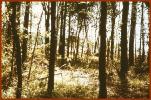
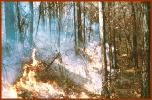
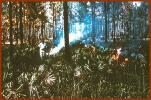
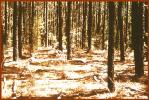
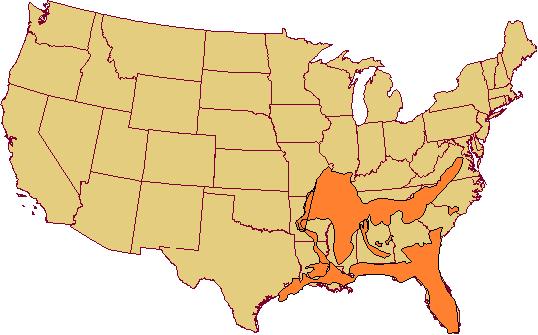
There is some grazing of the northern parts of the eastern forest regions, but the major range areas lie in the south. The major southern range types are:
Upland hardwoods - bluestem
Prairie
Shortleaf - loblolly pine - bluestem
Longleaf pine - bluestem
Longleaf - slash pine - wiregrass
Cedar - bluestem
Everglades
Bottomland hardwoods and cane
Marsh
Climate. Precipitation in the region is evenly distributed throughout the year and averages 100-150 cm annually. The growing season is long, about 200 to 280 days for the tallgrass species. Summers are hot and humid, and winters mild.
Soils. Soils in the region are of three orders: (1) Ultisols - low in base content with a subsurface horizon of accumulated clay (hardpan), (2) Spodosols - low in base content with a subsurface horizon of amorphous materials consisting of organic matter and compounds of iron and aluminum. These soils are usually coarse-textured and acid in reaction and (3) Entisols - these soils have no distinct horizonation. All of the above soils are low in organic matter, acid in reaction, and deficient in the major plant nutrients.
Vegetation. Of the aforementioned range types, the longleaf-slash pine (Pinus palustris and P. elliottii) ecosystem is the most important. The stand is open in many areas and has an understory of tall grasses when burning is regularly practiced. Among the important grasses are: bluestems (Andropogon), panicums (Panicum), uniolas (Uniola), carpetgrass (Axonopus), threeawns (Aristida) and paspalums (Paspalum). On unburned areas, numerous woody shrubs and vines and deciduous hardwood trees are common, which reduces the value of the area for grazing.
Management. Forage resources include large acreages of bermudagrass (Cynodon dactylon). Commonly, tame pasture, farmed forages, and forested range are used in a forage system. Forage production of longleaf-slash pine range varies from 0-4500 kg/ha depending on amount of tree overstory. During the last 20 to 25 years the combination of better cattle breeding, better nutrition, and improved forage management in the Georgia Coastal Plain Experiment Station has raised the percent calf crop from 57 to 76 and the average weaned weight from 123 to 193 kg. Besides timber and cattle, the area now produces deer and quail hunting, picnicking, and camping. Controlled burning of the Pine-Cane, Pine-Bluestem, and Pine-Wiregrass types in the southeast region has increased both lumber and forage production. Succession in the area is toward a hardwood climax which is slow-growing and excludes grazing. Much of the area is now maintained by prescribed fire which supports pine, cattle, and wildlife populations in abundance.